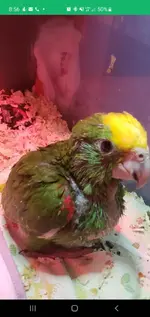Things can go bad very quickly with unweaned babies. Every year at this time lots of people come on with unweaned babies in trouble. Sadly most of them die!! We get gutted. So the best thing to save a baby is act quickly, and get to an avian veterinarian!
I would suggest at least contacting an avian vet specialist and try to do a video consultation. Most of have to drive around 2hrs to get go our avain veterinarian.
Personally, I wouldn't play around, I get him to veterinarian right away, an avain specialist.
https://www.ask-noodles.com/uncommon-problems-with-hand-feeding.html
"
Complications
1 – Crop Stasis
The crop should completely empty between feedings. Food that remains in the crop too long may “sour” and provide an excellent growth media for opportunist bacteria and fungi.
Hard lumps may form in the crops of some babies if the solid matter of the hand feeding formula separates from water. Treatment consists of feeding a little warm water and massaging the crop/lump until it is dissolved. The next feeding should consist of diluted formula following which the crop should be back to normal.
Crop Stasis
Your avian veterinarian should be consulted immediately should the crop content not empty as a crop wash can be performed by an experienced pediatric care technician or veterinarian to remove the soured content and the chick evaluated to determine what is the cause of the crop disorder and possible medical or therapeutic intervention.
Under feeding may result in result in some babies ingesting bedding material. In a case of eclectus parrots ingesting wood-shavings they all died due to the gizzard damming up, preventing normal digestion (Smith, 1985).
2 – Crop Burn
If the temperature of the food is greater than 41°C (105°F) it may scald the crop and cause necrosis and fistulation (Giddings, 1986). Even with careful mixing and cooking some of the most experienced facilities may burn babies’ crops by feeding hot formula. Microwaves are usually used when overcooked food is fed. Hot areas within the food may go undetected even with a thermometer. It is best to let the formula stand for a minute, mix well and double check the temperature.
3 – Constricted Toes
Avascular digital necrosis or “big toe” is seen in baby macaws, eclectus and african greys. A ring of fibrous tissue may be initiated by rapid loss of body fluids from a crack of skin and encircles the toe leading to a constriction (Clipsham, 1989b).
Higher ambient humidity levels are reported to decrease this problem (Clipsham, 1989b; Joyner, 1987).
4 – Aspiration
On several occasions very young, less than 3 days old, weak babies were accidentally aspirated at HARI. This may have been due to poor feeding responses and force feeding. It is also possible to drop a baby onto its full crop resulting in the food being forced out and into the buccal cavity. The baby, not expecting food at that time may aspirate it. Feeding older birds by a tube placed into the crop will decrease the likelihood of aspiration in the more difficult species to feed (Joyner, 1987), such as 2 month old cockatoos."
Above taken from below
https://hari.ca/hari/research-facil...cine-pediatrics-housing-feeding-baby-parrots/





